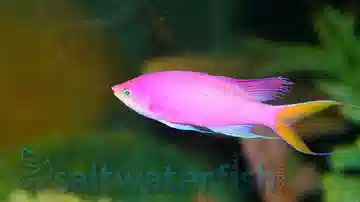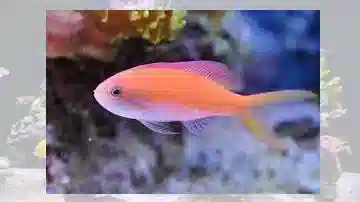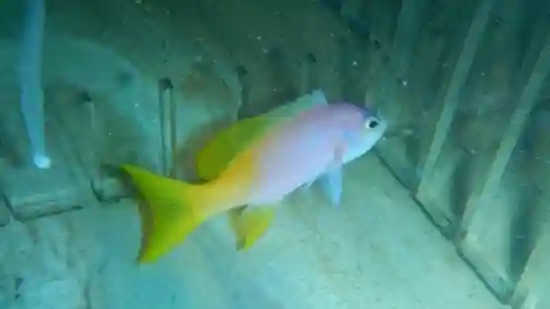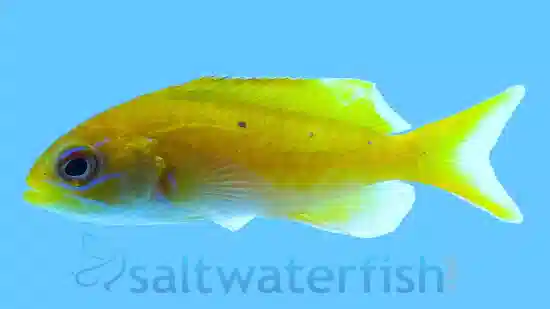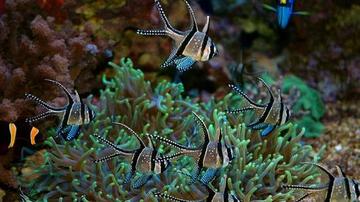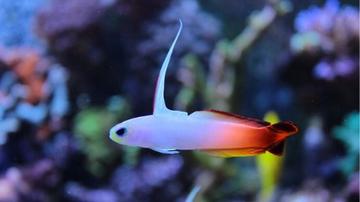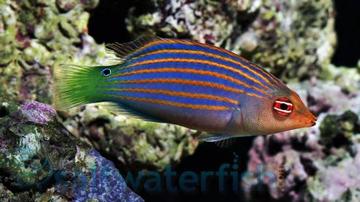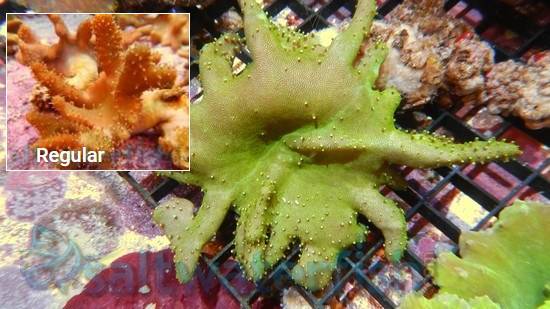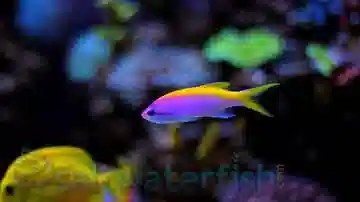Evansi Anthias
Mirolabrichthys evansi
(1 Reviews)
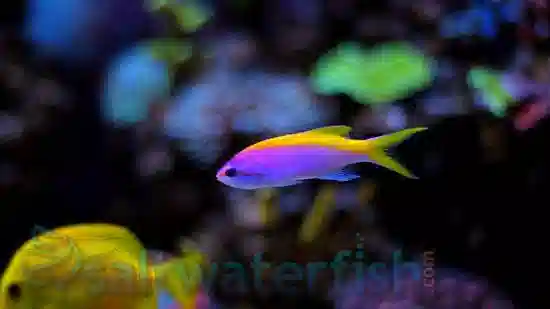
Evansi Anthias
Mirolabrichthys evansi
(1 Reviews)
{{ item.name }}
Size: {{ item.extra_field_3 }}
${{ getFormattedPrice(item.saleprice) }} ${{ getFormattedPrice(item.price) }}
To join the waiting list, click here
Free Shipping
With
$199.00
or more in Marine Life.
More details...
Evansi Anthias Care Facts
| Care Level: | Expert |
|---|---|
| Temperament: | Peaceful |
| Diet: | Carnivore |
| Reef Safe: | Yes |
| Minimum Tank Size: | 70 gallons |
| Max Size: | 4 inches |
Evansi Anthias (Mirolabrichthys evansi) - A Comprehensive Guide for Saltwater Marine Aquariums
This detailed guide provides valuable information about the Evansi Anthias (Mirolabrichthys evansi), a vibrant and popular species in saltwater marine aquariums. Covering various aspects of this species, including its habitat, reef compatibility, size, lifespan, diet in captivity, aquaculture availability, sexual dimorphism, symbiotic relationships, juvenile vs. adult coloration, compatibility with other fish and invertebrates, temperament, tank requirements, and detailed water conditions, this guide aims to assist both beginners and experienced hobbyists in successfully keeping and appreciating these beautiful fish in their aquariums.
Habitat of the Evansi Anthias (Mirolabrichthys evansi):
The Evansi Anthias, scientifically known as Pseudanthias evansi, is native to the Western Pacific Ocean. These striking fish are commonly found in coral-rich areas, particularly around reef slopes and lagoons. In the wild, they inhabit depths ranging from 15 to 40 meters.
Reef Safe Nature of Evansi Anthias:
The Evansi Anthias is considered reef-safe and is a suitable choice for reef aquariums. These fish tend to explore the nooks and crannies of the reef, adding movement and color to the ecosystem without posing a threat to corals and other invertebrates.
Size of the Evansi Anthias:
Evansi Anthias typically reach a size of about 3 to 4 inches (7.5 to 10 centimeters) when fully mature. Their moderate size makes them well-suited for smaller to medium-sized aquariums.
Lifespan of the Evansi Anthias:
When provided with optimal care and a suitable environment, Evansi Anthias can live for an average of 5 to 7 years in captivity, making them a rewarding and relatively long-term addition to marine aquariums.
Diet in Captivity:
In the wild, Evansi Anthias are omnivorous, primarily feeding on zooplankton. To replicate their natural diet in captivity and maintain their health and vibrancy, it is essential to provide a well-rounded diet that includes:
- High-quality marine flake or pellet foods
- Frozen or live foods such as brine shrimp, mysis shrimp, and copepods
- Phytoplankton and zooplankton-based feeds or supplements
Aquaculture Availability:
Evansi Anthias are occasionally available through aquaculture efforts, although most specimens in the aquarium trade are still wild-caught. It's essential to source them from reputable suppliers who adhere to sustainable and ethical collection practices.
Sexual Dimorphism in Evansi Anthias:
Evansi Anthias exhibit significant sexual dimorphism, with males and females displaying distinct differences in coloration and size. Males are larger and showcase vibrant coloration, while females are smaller and more subdued.
Symbiotic Relationships:
Evansi Anthias form loose aggregations in their natural habitat, often consisting of a dominant male and several females. These groups help provide protection from predators and allow individuals to forage more effectively.
Juvenile vs. Adult Coloration:
Juvenile Evansi Anthias have a more subdued coloration, featuring shades of pink and yellow. As they mature into adulthood, males develop a brilliant orange-red coloration with distinct markings on their dorsal fins, while females maintain their more subdued coloration.
Compatibility with Other Tank Inhabitants:
When considering Evansi Anthias for your saltwater aquarium, compatibility with other tank inhabitants is crucial to maintaining a harmonious environment.
Temperament of Evansi Anthias:
Evansi Anthias are generally peaceful, but individual temperament can vary. They do well in small groups of one dominant male and multiple females. However, keeping multiple males in the same tank can lead to aggression and territorial behavior. To mitigate potential attacks, provide ample hiding places and use a larger aquarium to disperse aggression effectively.
Suitable Tank Mates:
Here are five compatible tank mates that can potentially coexist peacefully with Evansi Anthias:
- Royal Gramma (Gramma loreto): Known for their peaceful nature, Royal Grammas are popular among saltwater aquarium enthusiasts and can cohabitate with Evansi Anthias.
- Yellow Watchman Goby (Cryptocentrus cinctus): These peaceful gobies are a great addition to community tanks and can share a tank with Evansi Anthias.
- Fire Shrimp (Lysmata debelius): These invertebrates can add visual interest to the aquarium while contributing to its overall health by acting as cleaner shrimp.
- Bubble Tip Anemone (Entacmaea quadricolor): If you have a reef aquarium, consider adding a bubble tip anemone. Evansi Anthias can coexist alongside compatible anemone species.
- Various Soft and LPS Corals: Incorporating soft and large polyp stony (LPS) corals into your aquarium can provide additional beauty and shelter for your Evansi Anthias.
Tank Requirements:
Creating an ideal environment is crucial for the well-being of Evansi Anthias. Here are some essential tank requirements:
- Minimum Tank Size: A tank with a capacity of at least 70 gallons is recommended to provide ample swimming space and accommodate their schooling behavior.
- Aquascaping: Incorporate live rock structures and coral formations to mimic their natural habitat. Create open swimming areas in the front of the tank while providing hiding spots and caves for retreat and shelter.
- Lighting: Moderate to high-intensity lighting is preferable, as it supports the health of photosynthetic organisms in the tank, including corals.
- Water Conditions: Maintain stable water conditions with the following parameters:
- pH: 8.1 to 8.4
- Salinity: 1.020 to 1.025
- Water Temperature: 74°F to 78°F (23°C to 26°C)
- Water Flow: Provide moderate water movement and ensure calmer water for resting and feeding areas.
Why People Should Buy the Evansi Anthias from Saltwaterfish.com:
Purchasing Evansi Anthias from reputable suppliers like Saltwaterfish.com ensures you receive healthy, well-cared-for specimens. These suppliers prioritize ethical and sustainable collection practices, contributing to the protection of these captivating fish in the wild.
In conclusion, the Evansi Anthias (Pseudanthias evansi) is a striking addition to saltwater marine aquariums, known for its vibrant colors and graceful appearance. Their compatibility with reef environments makes them a popular choice for reef enthusiasts. To provide these fish with a thriving home, they must meet their specific requirements regarding tank size, diet, and tank mates. When sourced responsibly from reputable suppliers, Evansi Anthias contributes to the sustainability of the marine aquarium hobby.
The Evansi Anthias - Africa was shipped extremely well, and it was a perfect addition to my reef tank. I acclimated according to the instructions, and I have had no problems with any of the fish I have received. What more can you ask for? Cheaper then my local fish store and it was delivered to my front door the next day.
Reviewed by: Jamison Tillar on Sept. 11, 2021


